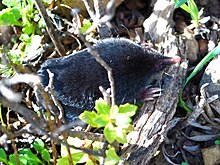Scapanus
This is an old revision of this page, as edited by Monkbot (talk | contribs) at 07:08, 8 January 2021 (Task 18 (cosmetic): eval 4 templates: hyphenate params (2×);). The present address (URL) is a permanent link to this revision, which may differ significantly from the current revision.
This article needs additional citations for verification. Please help improve this article by adding citations to reliable sources. Unsourced material may be challenged and removed. Find sources: "Scapanus" – news · newspapers · books · scholar · JSTOR (February 2014) (Learn how and when to remove this message) |
| Scapanus | |
|---|---|

| |
| Broad-footed mole (Scapanus latimanus) | |
| Scientific classification | |
| Domain: | Eukaryota |
| Kingdom: | Animalia |
| Phylum: | Chordata |
| Class: | Mammalia |
| Order: | Eulipotyphla |
| Family: | Talpidae |
| Tribe: | Scalopini |
| Genus: | Scapanus Pomel, 1848 |
Scapanus is a genus of moles in the family Talpidae. They live in North America from west of the Rockies south to Baja California del Norte, and north to British Columbia, wherever conditions permit a mole population; that is to say, apart from the most sandy, rocky, or developed places. As they are one genus, they are very closely related, but as species, they rarely if ever interbreed successfully.
It contains the following living species:
- Broad-footed mole (S. latimanus)
- Coast mole (S. orarius)
- Townsend's mole (S. townsendii)
In addition, there are several extinct species known from fossils.
- Scapanus hagermanensis (Mid Blancan stage, Idaho)[1]
- Scapanus malatinus (Blancan-Quaternary, California)[2]
- Scapanus proceridens (Miocene, Oregon and Idaho)[3]
- Scapanus shultzi (Miocene, California and Oregon)[4]
Distribution
Townsend's mole is primarily a Californian mole, although its range spills over into neighboring states. The broad-footed mole lives primarily in western Oregon, Washington, and southwestern British Columbia, where it often overlaps the smaller range of the Pacific or coast mole, which, as the name implies, does not tend to range as far inland. The broad-footed is one of the largest and most powerful moles, while the coast mole is a quite average-sized mole.
References
- ^ Hutchison, J. H. (1987). "Late Pliocene (Blancan) Scapanus (Scapanus)(Talpidae: Mammalia) from the Glenns Ferry Formation of Idaho" (PDF). PaleoBios. 12 (45): 1–7.
- ^ Hutchison, J. H. "Moles of the Scapanus latimanus group (Talpidae, Insectivora) from the Pliocene and Pleistocene of California". Contributions in Science, Natural History Museum of Los Angeles County. 386: 1–15..
- ^ "Scapanus proceridens Hutchison 1968 (mole)". Paleobiology Database. Retrieved February 2014.
{{cite web}}: Check date values in:|access-date=(help) - ^ "Scapanus shultz Tedford 1961". Paleobiology Database. Retrieved February 2014.
{{cite web}}: Check date values in:|access-date=(help)
- Scapanus, IUCN
